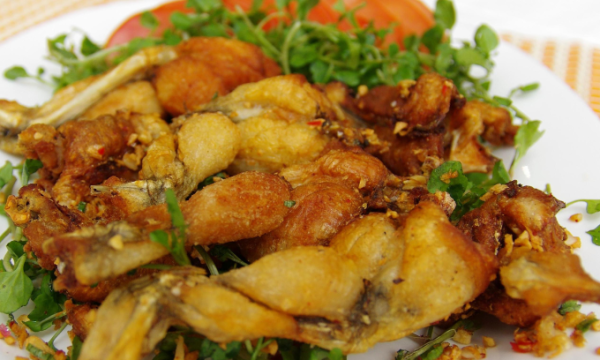
Frog legs are a signature of French cuisine, found in both high-end restaurants and home kitchens, often simply sautéed with butter and parsley.
The South China Morning Post reported that France’s annual consumption of frog legs reaches approximately 4,000 tonnes, most of which comes from imports.
According to DWin 2015, the European Union imported 4,234 tonnes of frog legs, which equates to the limbs of approximately 84 to 200 million frogs.
This high demand is triggering environmental and ethical concerns in supplying countries. In France, edible frog species have been protected for decades, with strict limits on harvesting. In the Bourgogne – Franche – Comté region, wild frogs may only be caught between late February and April during the breeding season.
|
Fried frog legs. Photo by Jamja/Handout via VnExpress |
However, over 2,500 tonnes of frog legs are imported each year, mostly from wild populations in Indonesia, Turkey, and Albania, as well as from frog farms in Vietnam. This dependency is threatening rare frog species and disrupting ecosystems in exporting countries.
In 2024, over 500 experts urged President Macron to curb frog species overexploitation and strengthen protections, CNN reported.
Research shows that some species, like Limnonectes macrodon, has vanished from France’s import list, while Fejervarya cancrivora and Fejervarya limnocharis have declined due to overharvesting.
Experts urge France to protect vulnerable species via The Convention on International Trade in Endangered Species of Wild Fauna and Flora (CITES).
Widespread frog hunting in Southeast Asia – especially in Indonesia – threatens unrecorded species and disrupts food chains.
“The trade in frog legs is hardly regulated or monitored by the government,” Indonesian amphibian specialist Ganjar Cahyadi said in an interview with SCMP.
In Vietnam, wild frogs are now rare, yet no export restrictions are in place. Frogs help control insect populations like mosquitoes and locusts, reducing pesticide use and improving water quality in ponds and lakes.
Frog farming is seen as a sustainable solution. Patrice Francois pioneered France’s first frog farm in Pierrelatte in 2010 to supply sustainable frog legs to high-end restaurants. But only three such farms exist today, producing just 10 tonnes annually, a fraction of national demand, according to food magazine The Takeout.
While domestic farming offers hope, meeting France’s full demand remains a major challenge. If import regulations tighten, frog legs may become a luxury.
Balancing culinary tradition, biodiversity protection, and global trade will shape the future of this French delicacy and its impact on exporting countries.
-
DDA announces deadline for vacating Signature View Apartments

-
NLC India Ltd to invest Rs 1.25 lakh cr capex by 2030, bets big on renewable energy

-
India launches first field trial using waste plastic geocells to build roads in difficult terrains

-
IIT Guwahati celebrates 27th Convocation with 2093 graduating students

-
Garena Free Fire Max Redeem Codes for July 13: Unlock 10+ free rewards including skins, diamonds & weapons today
